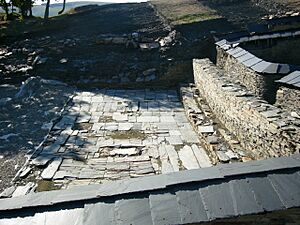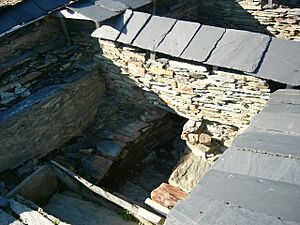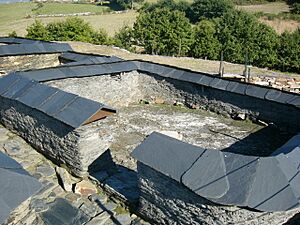Chao Samartín facts for kids
Chao Samartín is an ancient fortified village, known as a castro, found in Grandas de Salime, Asturias, Spain. It was first built a very long time ago, around 800 BCE, during the Bronze Age. Archaeologists discovered this old village in 1977.
Life in the Bronze Age
The first people to live at Chao Samartín arrived around 3,000 years ago, at the end of the Bronze Age. They built strong defenses to protect their village. These defenses included a deep ditch, called a moat, and a wooden fence, known as a palisade.
These defenses surrounded a special area that might have been sacred. To enter, people had to pass through a gate guarded by large rocks. Inside this area, there was a large building for that time, covering about 60 square meters.
Life in the Iron Age
As time passed, during the Iron Age, the village of Chao Samartín grew much bigger. By the 4th century BCE, the defenses were even stronger. They had a thick wall and several moats.
Inside the village, people lived in homes that were either round or rectangular with rounded corners. These houses usually had one room and a roof made from plants. The only way into the village was from the south, through a big gate over a moat.
The people of Chao Samartín were farmers. They cooked their food in ceramic pots and pans. They also used tools made from iron, copper, silver, and even gold. Many of these tools and objects have been found by archaeologists. During this time, the first sauna was built in the village.
The Roman Period
When the Roman Empire arrived, life at Chao Samartín changed. It became a time of peace and growth. The village no longer needed its strong defenses as much. This was because there were several gold mines nearby, which brought wealth to the people.
However, this good time ended suddenly. The village was abandoned after an earthquake hit around the 2nd century CE.
Discovering the Past
Archaeologists started digging at Chao Samartín in 1990. There is still a lot of the old village hidden underground that hasn't been explored yet. The investigations have shown that the settlement was left very quickly. This is clear because many tools, jewelry, and other valuable items from the Roman Period were found, as if people left them behind in a hurry.
See also
 In Spanish: Castro El Chao Samartín para niños
In Spanish: Castro El Chao Samartín para niños
- Castro culture




